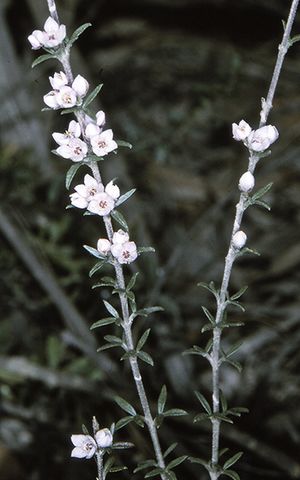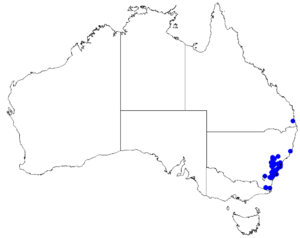Stiff boronia facts for kids
Quick facts for kids Stiff boronia |
|
|---|---|
 |
|
| Boronia rigens in Morton National Park | |
| Scientific classification | |
 |
|
| Occurrence data from Australasian Virtual Herbarium |
The stiff boronia (its scientific name is Boronia rigens) is a special plant found only in south-eastern New South Wales, Australia. It's part of the citrus family, called Rutaceae. This plant is a small, bushy shrub with leaves that have three parts. Its flowers are white or light pink and have four petals. You'll find these flowers growing where the leaves meet the stem.
What Does It Look Like?
The stiff boronia is a small, bushy plant that usually grows about 20 to 40 centimeters (8 to 16 inches) tall. Its younger stems can be a bit hairy.
Its leaves are quite interesting! Each leaf is made up of three smaller leaflets, like a tiny clover. These leaflets are thick and often have small bumps on them. They are narrow, about 3 to 6 millimeters (0.1 to 0.2 inches) long and 1 to 2 millimeters (0.04 to 0.08 inches) wide. A small stalk, called a petiole, connects the leaf to the stem.
The flowers are white or light pink. They grow one by one where the leaves join the stem, on a tiny stalk called a pedicel. Each flower has four sepals (small leaf-like parts that protect the bud) and four petals. The petals are about 2.5 to 3.5 millimeters (0.10 to 0.14 inches) long.
Inside the flower, there are eight stamens, which are the parts that make pollen. They are different lengths. The stigma (the part that receives pollen) is about the same width as the style (the stalk connecting the stigma to the ovary).
This plant usually flowers in July and August. After flowering, it produces a small, smooth fruit called a capsule, which is about 2.5 to 3.5 millimeters (0.10 to 0.14 inches) long.
How It Got Its Name
The stiff boronia was first officially described in 1863 by a scientist named George Bentham. He first called it Boronia polygalifolia var. robusta.
Later, in 1929, another scientist named Edwin Cheel gave it its current name, Boronia rigens. He published this description in a scientific journal. The word rigens in its name might refer to how stiff or rigid this plant looks compared to some other similar boronia plants.
Where Does It Live?
You can find Boronia rigens growing in open areas called heathlands and in forests. Sometimes, it even grows on sand dunes that have become stable. It is found in an area between Bombala and Mt Coricudgy, which is east of Rylstone in New South Wales.

